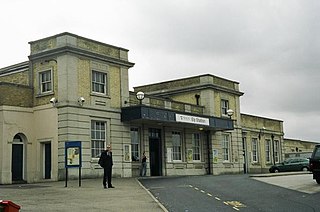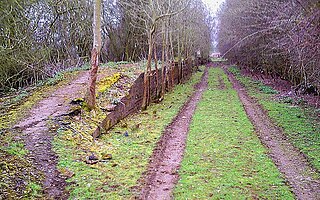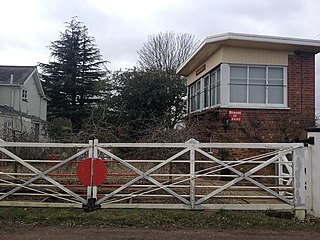
Yeovil Junction is the busier, but less central, of two railway stations serving the town of Yeovil in Somerset, England; the other is Yeovil Pen Mill. The station is sited 2 miles (3.2 km) outside the town, in the village of Stoford; although Yeovil is in Somerset, the station was in Dorset until 1991. It is located 122 miles 48 chains (197.3 km) down the line from London Waterloo.

Ipswich railway station is on the Great Eastern Main Line in the East of England, serving the town of Ipswich, Suffolk. It is 68 miles 59 chains (110.6 km) down the line from London Liverpool Street and, on the main line, it is situated between Manningtree to the south and Needham Market to the north.

Haywards Heath railway station is on the Brighton Main Line in England, serving the town of Haywards Heath, West Sussex. It is 37 miles 59 chains down the line from London Bridge via Redhill and is situated between Balcombe and Wivelsfield. It is managed by Southern.

Ely railway station is on the Fen line in the east of England, serving the cathedral city of Ely, Cambridgeshire. It is 70 miles 30 chains (113.3 km) from London Liverpool Street and is situated between Waterbeach and Littleport stations on the Fen line to King's Lynn. It is an important junction for three other lines: the Ely to Peterborough Line, the Ipswich to Ely Line and the Norwich to Ely line.

Peterborough railway station serves the cathedral city of Peterborough, Cambridgeshire, England. It is sited 76 miles 29 chains (122.9 km) north of London King's Cross. The station is a major interchange serving both the north–south East Coast Main Line, as well as long-distance and local east–west services. The station is managed by London North Eastern Railway. Ticket gates came into use at the station in 2012.

Stamford railway station serves the town of Stamford in Lincolnshire, England, and is located in St Martin's. The station is 12.5 miles (20 km) west of Peterborough. It was opened by the Syston and Peterborough Railway, part of the present day Birmingham to Peterborough Line. CrossCountry operate the majority of services as part of their Birmingham to Stansted Airport route. It is owned by Network Rail and managed by East Midlands Railway

Ashwellthorpe was a railway station that existed in the village of Ashwellthorpe, Norfolk, on a cutoff line between Forncett and Wymondham. This entry covers the history of the line and the station.

Wansford railway station is the headquarters of the Nene Valley Railway in Cambridgeshire, England. The station building was opened in 1995 and contains a ticket office, shop, cafe and toilets. The locomotive sheds are located at this station. Also at the station there is a picnic area and children's playground. The station was formerly the junction for a branch to Stamford, which separated to the north just east of the river bridge at Wansford.

The A6121 is a short cross-country road in the counties of Lincolnshire and Rutland, England. It forms the principal route between Bourne and Stamford and the A1 in Lincolnshire, continuing on through Ketton in Rutland to its junction with the A47 at Morcott. Its south-western end is at 52°35.5860′N0°38.0820′W and its north-eastern end is at 52°45.9120′N0°24.0660′W. The road has increased in importance with the rapid expansion of housing in this part of South Kesteven.

Haughley railway station was located in Haughley, Suffolk on the Great Eastern Main Line between Liverpool Street Station and Norwich. It opened on 2 July 1849 named Haughley Junction and was a replacement for a station named Haughley Road which had been in service from 1846 to 1849 at location TM 02981 63319 on the line to Elmswell.

Luffenham railway station is a former station of the Syston and Peterborough Railway serving the villages of North and South Luffenham, Rutland.

Ketton and Collyweston railway station is a former station serving the villages of Ketton, Geeston, Aldgate and Collyweston, Rutland. It is located in Geeston adjacent to a level crossing on the Ketton to Collyweston road. It is under half a mile from Ketton but over a mile from Collyweston. It closed in 1966.

Oundle railway station is a Grade II listed former railway station in Oundle, Northamptonshire on the former Northampton and Peterborough Railway line which connected Peterborough and Northampton. In 1846 the line, along with the London and Birmingham, became part of the London and North Western Railway. At grouping in 1923 it became part of the London Midland and Scottish Railway.

Clifton Bridge railway station is a former railway station in the Bower Ashton district of Bristol, England, near the River Avon. It was opened in 1867 by the Bristol and Portishead Pier and Railway Company as a single platform stop 3.4 miles (5.5 km) along the line from Bristol to Portishead. It was later taken over by the Great Western Railway and had a second platform added.
The Rugby and Stamford Railway was an early railway in England built in 1850. The London and Birmingham Railway had already built a branch from Blisworth to serve Northampton and extend to Peterborough. The success of this, the Northampton and Peterborough Railway encouraged the directors to look for other ventures. They decided upon a branch from Rugby to Stamford which would link up with other new railways in the east of the country.

Clifton Mill railway station was a railway station serving Clifton-upon-Dunsmore in the English county of Warwickshire. It was opened on the Rugby and Stamford Railway in 1864.

Lilbourne railway station was a railway station serving Lilbourne and nearby Catthorpe in Leicestershire, England. It was on the Rugby and Stamford Railway between Clifton Mill and Yelvertoft and Stanford Park.

Welford and Kilworth railway station was a railway station serving Welford and the villages of North Kilworth and South Kilworth in Leicestershire, England. It was opened as Welford on the Rugby and Stamford Railway in 1850.

Theddingworth railway station was a railway station serving Theddingworth in Leicestershire, England. It was opened on the Rugby and Stamford Railway in 1850.
The Syston and Peterborough Railway was an early railway in England opened between 1846 and 1848 to form a connection from the Midland Counties Railway near Leicester to Peterborough, giving access to East Anglia over the Eastern Counties Railway. The project was part of the ambition of George Hudson to establish and maintain a monopoly of railway service over a large area of England. The surveying of the line achieved notoriety when Robert Sherard, 6th Earl of Harborough, who was hostile to railways, arranged a battle to obstruct surveys of the proposed line, and later of its construction.



















